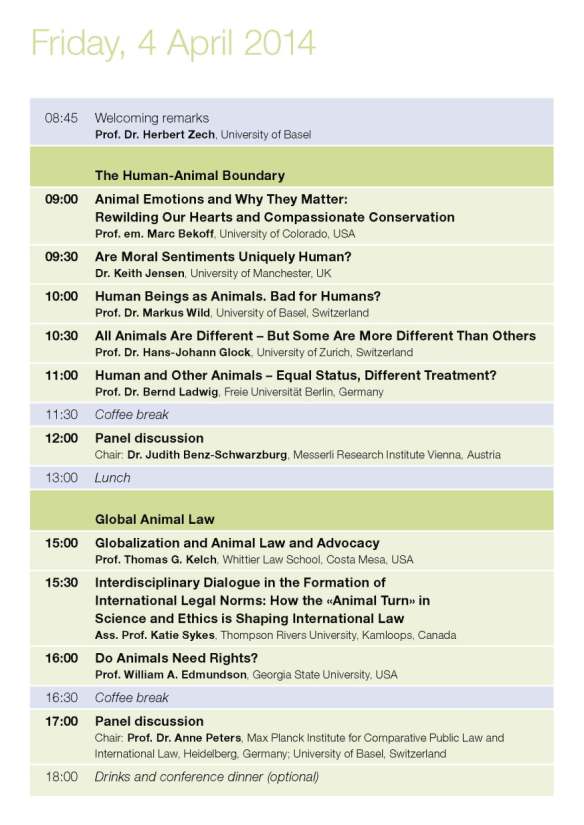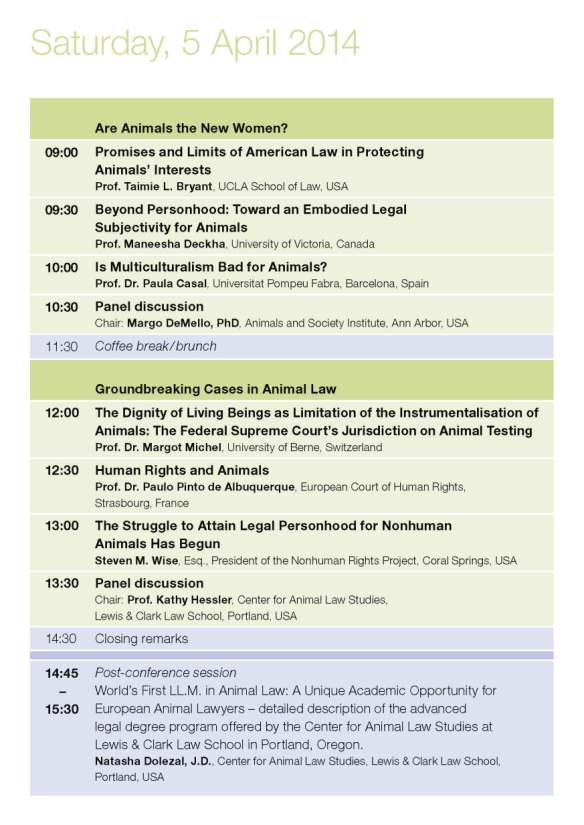The Animal Turn and the Law
Interdisciplinary Perspectives and New Directions in Animal Law
1st Annual European Animal Law Conference
April 4-5 2014, University of Basel, Switzerland

In the last decade, a turn in academia has occurred, exhibiting an increasing scholarly interest in animals, the complex relationships between humans and other animals, and the role and status of animals in (human) society. The scholarly study of animals is far from new. It stretches throughout most of history of science, where animals have been the objects of research in life sciences, or where they served as objects of comparison and distinction in the modernist project of philosophical anthropology. It is however only in the last decade that animal studies have emerged in the broader academic context, specifically in humanities and social studies, transcending the realm of natural sciences. The novel focus on animals marks a significant change not only quantitatively – as demonstrated by the recent explosion of publications, journals, studies, and conferences related to this topic – but also a qualitative shift. Human-animal studies (or animal studies, anthrozoology) start from a genuine interest in the animal and its place in society and manifest a new perception of animals as animal selves, as subjects as opposed to objects. This signifies a departure from the perception of the animal as the “antithetical other”.
This recent development has been sparked to a considerable degree by new findings of cognitive ethology, which have brought animals closer to humans than previously acknowledged. Also, the proliferating ethical debate on the moral standing of animals is now applying the principle of equality and justice to the nonhuman context and is highlighting links between speciesism and intra-human discrimination (racism, sexism, ableism, etc.). The dividing line between humans and other animals is being continuously contested, and has been eroded on biological and ethical grounds over the past decades. The more we know in biology, the bigger the overlap in characteristics of members belonging to our own species and to other species appears. On the other hand, increased biological knowledge sheds light on biological differences especially on the genetic level.
It is of course an altogether different question (and this is the one that should interest legal scholars) which of the commonalities and differences are relevant for ethics and the law. The answer to what extent humans and (other) animals are morally different requires a value judgment. At this point, a number of preliminary questions arise, for example how to justify (i.e. give reasons for) our choice of a criterion. If no justification is given for limiting the “sphere of justice” to humans (by excluding animals), and for attributing rights to humans (not to other living beings), if these rights are said to flow from the intrinsic dignity that comes with being human, then such a statement is nothing more but pure speciesism. Is there one single decisive distinguishing criterion or are there several? Is the distinction not rather a cluster of predicates? How can we escape the self-bias inherent in our identification of those criteria?
The dividing line drawn by all sciences and the humanities has proven to be contingent in terms of academic disciplines, culture, and history. Depending on time and place, this boundary (as an intellectual construct) not only moves, but the reasons for placing animals and humans on either side of that boundary moves, too. Nevertheless, we submit that insights from the life sciences should inform moral (and legal) reasoning. Philosophical speculation about the essence of “humanness” is not enough. Arguments in favour of international legal codification of animal welfare to some extent depend on substantive evidence about what both humans and other animals are like (physiologically, emotionally, psychologically, socially, and so on). For example, the application of Martha Nussbaum’s capabilities approach to animal rights depends on which capabilities human and non-human animals really have and which they share. Overall, ethological and zoological insights should be one element and starting point of an informed legal debate. We must however keep in mind that, for purposes of the law, the human-animal divide is a social construction.
From this starting point, the rapidly growing human-animal studies move forward to explore novel areas of research, examining manifold aspects of the human-animal relationship from different perspectives. The emerging research field draws on a wide range of academic disciplines and promises new impulses in turn. The animal question has become a comprehensive inquiry into the complex and multifaceted human-animal relationship. It is this academic focus on animals in new terms and under new premises which characterises the “animal turn”. Coming from the margins, human-animal studies have the potential to question and deconstruct settled assumptions and to gain progressive momentum, similar to other “counter-hegemonic disciplines”.
The overall purpose of this conference is to shed light on the significance and implications of this novel academic trend for animal law. How do human-animal studies inform legal animal studies? How does the animal turn translate into law and jurisprudence? This question is particularly relevant with regard to the legal status of animals and the conceptualisation of animals and the human-animal relationship as reflected and shaped by law. Embracing interdisciplinary, innovative, or critical perspectives on current and future animal law, the conference aims at exploring cutting-edge areas and pointing to new directions in the broader context of law and animals.


